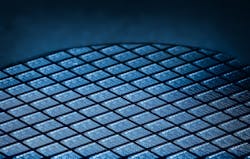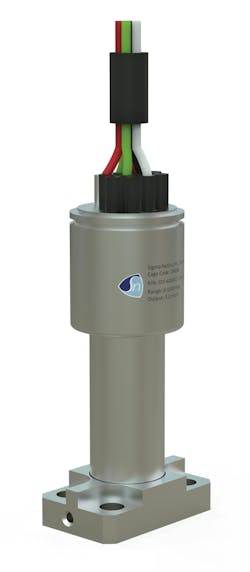Custom Pressure Transducer Delivers High-Temperature Accuracy
Designing high-performance pressure transducers can be a technical balancing act. While it’s relatively simple to design an accurate low range transducer with high output sensitivity, it is difficult to couple that with low thermal errors at extreme temperatures. Add in additional requirements—like a smaller form factor or lower mass—and the design challenge becomes even more difficult.
Basic physics limits many pressure transducer design and performance combinations that tend to be mutually exclusive in commodity sensors, including low-range accuracy, thermal performance and size. Striking a balance between these attributes is possible but requires a significant amount of custom engineering along with a deep understanding of pressure transducer components and calibration strategies. Traditional sensing technologies offer a few of these options in combination, but not all.
For example, bonded gauge sensors offer high accuracy at low pressures with excellent thermal performance and survivability, but they sacrifice size, requiring a significant strain field and room to bond. MEMS sensors offer high accuracy at low pressure ranges, high signal output and small size, but they perform poorly or even fail to survive at extreme temperatures, typically limited to under 200°F. Exceptions exist but can then be cost-prohibitive.
READ MORE: High-Precision Motion Components Drive Advances in Semiconductor Production
For a glimpse at what’s possible when a sensor is designed for demanding performance requirements, rather than bought as-is from a catalog, consider a model we recently created for a semiconductor application. This customized 0-100 PSIA sensor measures pressure as part of a semiconductor gas flow monitoring and control system. Performance requirements included an accuracy of 0.35% FSO TEB, frequent excursions to temperatures as high as 428°F and a high output signal of 100 mV.
Designed for flush-mount installation within the gas flow system, the sensor also needed to be small, with just a 12.7-millimeter (mm) diameter and 13.5-mm height. Conventional COTS solutions could not meet these application requirements.
The Problems With Accuracy, Heat and Size
Achieving this level of accuracy is not an issue for high-performance pressure transducers. Most of our off-the-shelf pressure transducers, for instance, offer a standard accuracy of 0.25% FSO static accuracy (not TEB) and can optionally reach accuracies better than 0.1% FSO static accuracy for operating temperature ranges between −65° and +250°F.
High temperatures, however, affect the sensor’s circuitry and strain gauges, introducing errors that reduce accuracy across the entire span. A typical high-temperature sensor operating at 428°F could exhibit a thermal error as high as 2.0% with standard thermal compensation techniques. Many off-the-shelf high-temperature models can’t achieve 428°F at all—at least not for long-term exposure—without limiting output options or requiring thermal isolation methods that increase the final product’s complexity.
Our new sensor design, by contrast, has a total error of 0.35% FSO TEB across a wide temperature range—from room temperature to 428°F. That total error includes linearity, hysteresis, repeatability and thermal effects on zero and span.
With this sensor, the combined features of low-range accuracy and high-temperature thermal performance don’t come at the expense of package size, where the three requirements tend to compete. Nor does it require traditional thermal wells or standoff tubes that require extra room within the sensor location.
In high-temperature applications, it is usually necessary to protect against heat either by using a standoff tube to “bleed” the temperature, adding mass to use as a heat sink or separating the electronics module to isolate the components that can’t tolerate high temperatures. Similarly, internal space is required to allow for the additional thermal compensation sensors. In addition, with low-range sensors, diaphragm thickness is limited by the outer diameter of the sensors: traditional diaphragm or beam designs yield to machine tooling pressures before desired thicknesses are reached, and media-isolated designs require complex geometries, further impacting the size, mass and number of internal components.
How It’s Done
Pushing the envelope on the compact low-range sensor’s thermal performance while minimizing its package size did not come down to an individual technical breakthrough. Instead, the improvements are rooted in careful application of known, but difficult, sensor design, manufacturing and calibration methods.
In particular, we paid close attention to materials used throughout the sensor, avoiding lower melting-point solders in favor of gold, using proprietary bonding techniques and selecting only heat-tolerant materials throughout the sensor. Likewise, we selected high-temperature electrical components for the signal conditioning circuitry.
READ MORE: Twisting and Bending a Layer of Semiconductor Materials in an LED Boosts its Efficiency
To ensure total error band accuracy across such a wide thermal range, we took the extra step of thermally matching the sensor’s individual strain gauges. Thermal matching boils down to a time-consuming process of identifying resistors with a similar Temperature Coefficient of Resistance (TCR)—and then creating the Wheatstone Bridge circuitry using these matched resistors. This technique reduces one of the key causes of thermal error: strain gauge performance variability. Strain gauges in a single lot “move” differently from one another as temperatures change due to variations in material conditions, starting resistance and TCR. Our process reduces this critical source of thermal performance uncertainty, allowing traditional techniques to further enhance performance.
Rather than thermally matching the strain gauges, the standard practice in the sensor industry is to compensate for the differences in strain gauge TCR with additional resistors or through a digital compensation board. These compensation methods include well-known active and passive measures that would not have allowed us to meet the 0.35% FSO TEB accuracy specification at high temperatures without adding size or additional components or impacting the sensor’s operating temperature capabilities.
READ MORE: The Semiconductor Race is On!
The Value of Custom Designs
While engineered for a specialized semiconductor application, this high-temperature low-range sensor does highlight the value of custom sensors for all difficult applications. The same design, manufacturing and calibration principles can be tailored to the requirements of other applications whose thermal performance, accuracy and package space requirements are not well-served by commodity sensors — including space exploration, aircraft, subsea vehicles, downhole oil and gas, high-temperature process industries, and more.
This article was submitted by Sean Gregory, director, Engineering Applications & Sales at Sigma-Netics.
Extreme Ingress Protection
Although some applications call for a custom design starting with a blank sheet of paper, you can still meet many challenging application requirements with the right commercial-off-the-shelf (COTS) unit. For example, some of the following transducers can withstand radiation, fatigue and submersion in underwater vehicles and high pressures in excess of 30,000 PSI:
- The SST 64X-RT radiation-tolerant mV/V pressure transducer features custom ATP, NDE, traceability and low mass for installations with limited space.
- The SST 144 high-pressure, fatigue-rated transducer can handle pressures in excess of 100,000 PSI. Units are available with extended temperature compensation ranges, high-level analog and digital outputs, and ±0.25-percent FSO accuracy.
- The SST 44X multi-purpose aerospace pressure transducer features shunt calibration, multi-temperature thermal sensor characterization and cryogenic options. Its all-welded, customizable design is ideal for all applications.
- The SST 44X-M miniaturized aerospace pressure transducer is a low-mass, highly accurate unit weighing in at less than 90 grams. Units feature a ¾-inch outer diameter, pressure ranges up to 10,000 PSI and a variety of wetted material options.
- The SST 74X-UV submersible vehicle depth transducer is a compact, 90-gram model with shallow diaphragm sensors and a configurable flange design for outboard or inboard bulkhead installation. Units include an all-welded hermetic construction that resists shock and vibration.
With their ruggedized design, these pressure transducers meet the requirements of demanding industrial and aerospace applications—including deep space missions. Other notable features include combined temperature and pressure measurement, remote electronics modules, wide standard temperature ranges (−65° to +250°F) and more.
In particular, we paid close attention to materials used throughout the sensor, avoiding lower melting-point solders in favor of gold, using proprietary bonding techniques and selecting only heat-tolerant materials throughout the sensor. Likewise, we selected high-temperature electrical components for the signal conditioning circuitry.
To ensure total error band accuracy across such a wide thermal range, we took the extra step of thermally matching the sensor’s individual strain gauges. Thermal matching boils down to a time-consuming process of identifying resistors with a similar Temperature Coefficient of Resistance (TCR)—and then creating the Wheatstone Bridge circuitry using these matched resistors.
This technique reduces one of the key causes of thermal error: strain gauge performance variability. Strain gauges in a single lot “move” differently from one another as temperatures change due to variations in material conditions, starting resistance and TCR. Our process reduces this critical source of thermal performance uncertainty, allowing traditional techniques to further enhance the performance.
Rather than thermally matching the strain gauges, the standard practice in the sensor industry is to compensate for the differences in strain gauge TCR with additional resistors or through a digital compensation board. These compensation methods include well-known active and passive measures that would not have allowed us to meet the 0.35% FSO TEB accuracy specification at high temperatures without adding size or additional components, or impacting the sensor’s operating temperature capabilities.
The Value of Custom Designs
While engineered for a specialized semiconductor application, this high-temperature low-range sensor does highlight the value of custom sensors for all difficult applications. The same design, manufacturing and calibration principles can be tailored to the requirements of other applications whose thermal performance, accuracy and package space requirements are not well-served by commodity sensors—including space exploration, aircraft, subsea vehicles, downhole oil and gas, high-temperature process industries and more.

